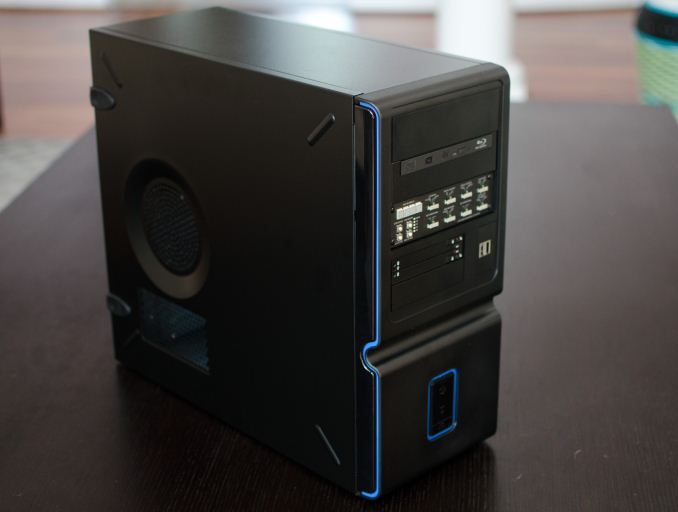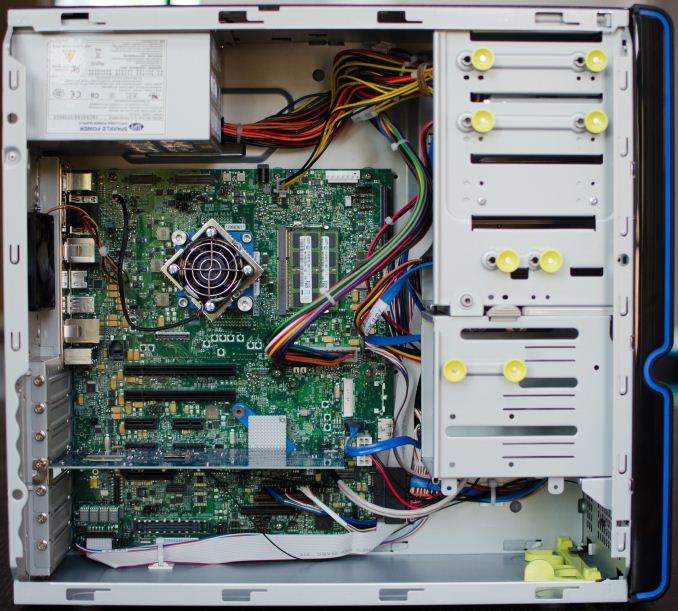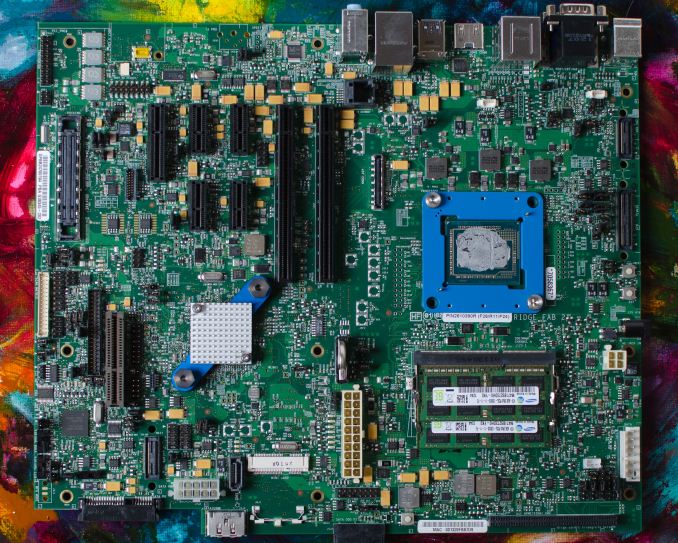Intel Iris Pro 5200 Graphics Review: Core i7-4950HQ Tested
by Anand Lal Shimpi on June 1, 2013 10:01 AM ESTThe Core i7-4950HQ Mobile CRB
At a high level, Iris Pro 5200 would seem to solve both problems that plagued Intel graphics in the past: a lack of GPU hardware and a lack of memory bandwidth. As a mostly mobile-focused design, and one whose launch partner isn’t keen on giving out early samples, it seemed almost impossible to evaluate Iris Pro in time for the Haswell launch. That was until a week ago when this showed up:
What may look like a funny mid-tower from a few years ago is actually home to one of Intel’s mobile Customer Reference Boards (CRB). Although the chassis is desktop-sized, everything inside is optimized for mobile. It’s just easier to build things larger, especially when it comes to testing and diagnosing problems.
The silicon on-board is a 47W Core i7-4950HQ, the lowest end launch SKU with Iris Pro 5200 graphics. The chassis is obviously overkill for a 47W part, but the performance we get with this machine should be representative of any i7-4950HQ system with a cooler capable of dissipating 47W.
If you read our Haswell CPU review you’ll know that Intel tried to be stingy with telling us die sizes and transistor counts for the bulk of the Haswell lineup, electing to only give us data on dual-core Haswell GT3 and quad-core Haswell GT2. Knowing that mobile parts ship without integrated heat spreaders, I went to work on pulling off the i7-4950HQ’s heatsink (after I finished testing, just in case).
With the heatsink off and thermal paste wiped off, I used my bargain basement calipers to get a rough idea of die area. This is what I came up with:
| Intel Haswell | |||||||||||||||||
| CPU Configuration | GPU Configuration | Die Size | Transistor Count | ||||||||||||||
| Haswell GT3e (QC) | Quad-Core | GT3e | 264mm2 + 84mm2 | ? | |||||||||||||
| Haswell GT2 (QC) | Quad-Core | GT2 | 177mm2 | 1.4B | |||||||||||||
| Haswell ULT GT3 | Dual-Core | GT3 | 181mm2 | 1.3B | |||||||||||||
The Crystalwell die measures 7mm x 12mm (84mm^2), while the quad-core Haswell + GT3 die is a whopping 264mm^2 (16.2mm x 16.3mm). Working backwards from the official data Intel provided (177mm^2 for quad-core GT2), I came up with an 87mm^2 adder for the extra hardware in Haswell GT3 vs. GT2. Doubling that 87mm^2 we get a rough idea of how big the full 40 EU Haswell GPU might be: 174mm^2. If my math is right, this means that in a quad-core Haswell GT3 die, around 65% of the die area is GPU. This is contrary to the ~33% in a quad-core Haswell GT2. I suspect a dual-core + GT3 design is at least half GPU.














177 Comments
View All Comments
Elitehacker - Tuesday, September 24, 2013 - link
Even for a given power usage the 650M isn't even to on the top of the list for highest end discrete GPU.... The top at the moment for lowest wattage to power ratio would be the 765M, even the Radeon HD 7750 has less wattage and a tad more power than the 650M. Clearly someone did not do their researching before opening their mouth.I'm gonna go out on a limb and say that vFunct is one of those Apple fanboys that knows nothing about performance. You can get a PC laptop in the same size and have better performance than any Macbook available for $500 less. Hell you can even get a Tablet with an i7 and 640M that'll spec out close to the 650M for less than a Macbook Pro with 650M.
Eric S - Tuesday, June 25, 2013 - link
The Iris Pro 5200 would be ideal for both machines. Pro users would benefit from ECC memory for the GPU. The Iris chip uses ECC memory making it ideal for OpenCL workloads in Adobe CS6 or Final Cut X. Discrete mobile chips may produce errors in the OpenCL output. Gamers would probably prefer a discrete chip, but that isn't the target for these machines.Eric S - Monday, July 1, 2013 - link
I think Apple cares more about the OpenCL performance which is excellent on the Iris. I doubt the 15" will have a discrete GPU. There isn't one fast enough to warrant it over the Iris 5200. If they do ever put a discrete chip back in, I hope they go with ECC GDDR memory. My guess is space savings will be used for more battery. It is also possible they may try to reduce the display bezel.emptythought - Tuesday, October 1, 2013 - link
It's never had the highest end chip, just the best "upper midrange" one. Above the 8600m GT was the 8800m GTX and GTS, and above the 650m there was the 660, a couple 670 versions, the 675 versions, and the 680.They chose the highest performance part that hit a specific TDP, stretching a bit from time to time. It was generally the case that anything which outperformed the MBP was either a thick brick, or had perpetual overheating issues.
CyberJ - Sunday, July 27, 2014 - link
Not even close, but whatever floats you boat.emptythought - Tuesday, October 1, 2013 - link
It wouldn't surprise me if the 15in just had the "beefed up" iris pro honestly. They might even get their own, special even more overclocked than 55w version.Mainly, because it wouldn't be without precedent. Remember when the 2009 15in macbook pro had a 9400m still? Or when they dropped the 320m for the hd3000 even though it was slightly slower?
They sometimes make lateral, or even slightly backwards moves when there are other motives at play.
chipped - Sunday, June 2, 2013 - link
That's just crazy talk, they want drop dedicated graphics. The difference is still too big, plus you can't sell a $2000 laptop without a dedicated GFX.shiznit - Sunday, June 2, 2013 - link
considering Apple specifically asked for eDRAM and since there is no dual core version yet for the 13", I'd say there is very good chance.mavere - Sunday, June 2, 2013 - link
"The difference is still too big"The difference in what?
Something tells me Apple and its core market is more concerned with rendering/compute performance more than Crysis 3 performance...
iSayuSay - Wednesday, June 5, 2013 - link
If it plays Crysis 3 well, it can render/compute/do whatever intensive fine.